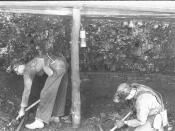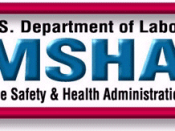Change is difficult to accept for many individuals and companies; however, change usually must happen in order to better a company especially with the changes in today's society. Many companies find that due to today's technology changes must be implemented. In organizations, some use an organizational psychologist to assist in implementing the changes. According to Steve Jex (2002, pg. 13), many organizational psychologists employed in nonacademic settings are involved in organizational change and development activities to include assisting an organization in the development and implementation of an employee opinion survey program, designing and facilitating the implementation of team development activities, or assisting top management with the strategic planning process. One field that must make implementations includes the mining field. Though implementations have not been placed fully in the mining industry, changes are being implemented to make mining safer for all employees.
In the past few years, Utah has had numerous deaths due to the safety measures taken by coal mining companies.
The most notable mining accident is the one at Crandall Canyon Mine in 2007 that killed or injured 16 miners. When mining for coal, underground mining is used when the coal deposit lies deep below the surface of the earth (Bureau of Labor Statistics, 2007). Coal mining underground can be very dangerous because miners are working in tunnels that are usually dark and damp. If a tunnel is not properly secured, a collapse can occur, ultimately causing injuries or deaths to the miners trapped in the tunnels. Some cities in Utah thrive on coal mining; therefore, providing a majority of the jobs within that city. With coal mining offering a majority of employment opportunities, safety should be a number one factor when mining.
According to the Bureau of Labor Statistics (2007), mine safety is regulated by the Federal Mine Safety and Health Act of 1977 and successive additional legislation, which has resulted in steadily declining rates of mining injuries and illnesses. Though mining is regulated, accidents do occur and can be catastrophic to those involved. The Crandall Canyon Mine incident was one of the worst collapses in 2007 and many blamed the government for this incident. The biggest fault that many find with the safety includes the absence of emergency communications equipment, the lack of adequate escape provisions, the refusal of the owners to equip miners with adequate emergency oxygen supplies, and the ad hoc and insufficient system for mobilizing rescue teams (Grey, 2007). Once the collapse at Crandall Canyon Mine occurred, investigations found many occurrences regarding safety and how mining was completed. Changes then had to be implemented to ensure that safety measures were being met.
Eleven days after the incident at Crandall Canyon Mine, Governor Jon M. Huntsman, Jr. issued an executive order to establish the Utah Mine Safety Commission that was responsible for reviewing the role of the State of Utah in the areas of mine safety, accident prevention, and accident response (Unbossed, February 2008). The Utah Mine Safety Commission made recommendations to improve safety, training, research, testing and certification, emergency procedures, and family support. The Crandall Canyon Mine incident was determined to be a cause of miscommunication and the Mine Safety and Health Administration (MSHA) not having all necessary information. In the wake of the Crandall Canyon disaster, Labor conducted a full audit of MSHA and found that the agency's Office of Coal Mine Safety and Health did not perform required inspections in 107 of the nations' mines and that 15% of the inspections performed were not documented (Broken Government, 2009).
Though changes have not been implemented in the mining industry, the change is imminent due to the mine-safety bill that was passed in January 2008. The act is called the Supplementary Mine Improvement and New Emergency Response Act (S-MINER). This act states that mine operators would be required to use new coal-dust monitors to reduce miners' exposure to coal dust, gives the federal Mine Safety and Health Administration subpoena authority; increase penalties for safety violations; place it completely in control of a rescue site, create an ombudsman's office to handle miners' safety complaints and allow for independent investigations when more than one miner is killed in an accident (Holland, January 2008).
Passing this act impacts many external stakeholders within the mining industry. The labor unions will become aware of the new changes and policies dealing with safety. These unions will have to implement changes to adapt to the new safety measures ensuring that all safety measures are met on behalf of the union members. Another external stakeholder that is affected will be the Mine Safety and Health Administration. MSHA will have to adapt the rules and regulations that are followed when approving proper mining sites, proper methods of mining, and records of inspections that have been completed at mine sites. In addition, MSHA will have to report findings to the proper authorities to ensure that all parties involved have the necessary information regarding a mine.
Implementing the Supplementary Mine Improvement and New Emergency Response Act will require all parties involved to make changes within the organization. Miners will have to change how he or she does a job; the boss of a mine operation will have to change the process he or she takes to get a mine site approved along with the procedure to excavate the mines, and the Mine Safety and Health Administration will have to implement changes to ensure that another unnecessary accident does not occur. Miners will potentially have better supplies should a collapse occur allowing for rescue efforts to be more successful. Changes will be implemented on how to excavate the coal without potentially causing a collapse. MSHA will have to hire more employees or task inspections to current employees. As inspections are completed, the findings should be properly documented and fines assessed if necessary. Ensuring that all miners are safe should be the number one priority of MSHA; therefore, conducting inspections must be completed. In addition, MSHA will have to makes changes to the procedures of how rescues should be performed and what measures need to be taken to make these rescues more successful. Finally, all parties involved will need education and training on the new policies and procedures implemented for the safety of the miners.
With all the changes being implemented, an organization must be held accountable to ensure that these changes have been properly implemented. In the mining industry, the government, the Department of Labor, the Department of Mining, and the individual Mining Coalitions should hold these organizations accountable to implement the changes. If the changes are not properly implemented, the organization must be confronted and put on notice. If the organization cannot properly implement the changes, the organization may need to fire the individual and hire an individual who is capable of completing the important task to implementing safety measures for miners.
Change is not easy to accept; however, when safety is involved, change is necessary to avoid preventable accidents that result in deaths or injuries. Until no accidents occur within the mining field, safety changes must continue to be implemented. According to the Bureau of Labor Statistics (2007), employment in the mining industry has been affected significantly by new technology and more sophisticated mining techniques that increase productivity requiring fewer, if any, human operators. Though technology has allowed the mining industry to prevent some accidents, miners are still being injured or killed in accidents. Until all mining operations are completed by machines and no miners are involved, safety must be the number one implementation within this field. Crandall Canyon Mine should never have happened if the proper measures had been taken with safety, inspections, and precautions. Implementing these changes will hopefully, prevent another horrible incident such as the Crandall Canyon Mine disaster.
ReferenceBroken Government. (2009). Oversight Collapse Leads to Mine Safety Issues. Retrieved on May 15, 2009 from http://www.publicintegrity.org/investigations/broken_government/articles/entry/982/Bureau of Labor Statistics. (2007). Career Guide to Industries: Mining. Retrieved on May 15, 2009 from http://www.bls.gov/oco/cg/cgs004.htmGrey, Barry. (August 8, 2007). The Utah min disaster: A tragic consequence of government-industry collusion. Retrieved on May 15, 2009 from http://www.wsws.org/articles/2007/aug2007/utah_a08.shtmlHolland, Jesse J. The Associated Press. (January 17, 2008). Democrats pass mine-safety bill over veto threat.Retrieved on May 15, 2009 from https://www.politicswest.com/node/17555/printJex, S.M. (2002). Organizational psychology: A scientist-practitioner approach. New Jersey: John Wiley and SonsUnbossed. (February 2, 2008). Mine Safety - The Report of the Crandall Canyon Mine Commission. Retrieved on May 15, 2009 from http://www.unbossed.com/index.php?itemid=1938


